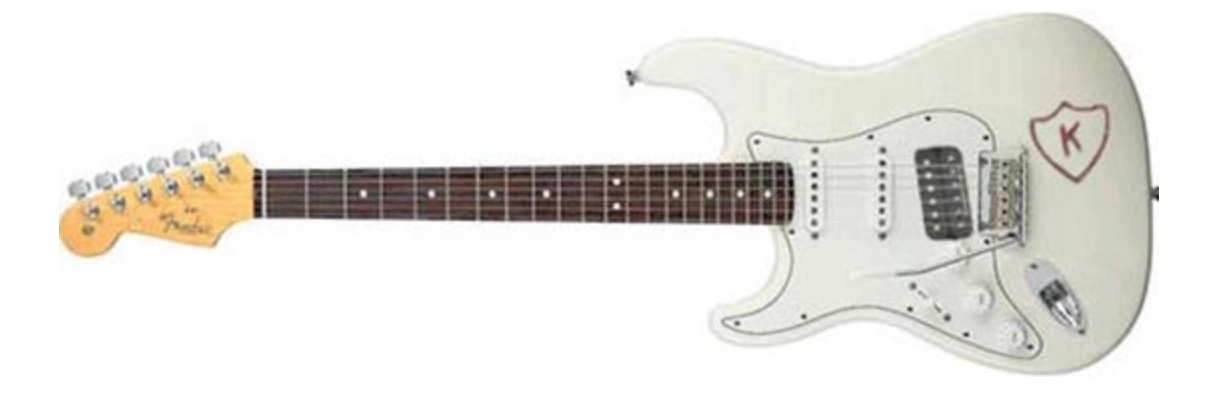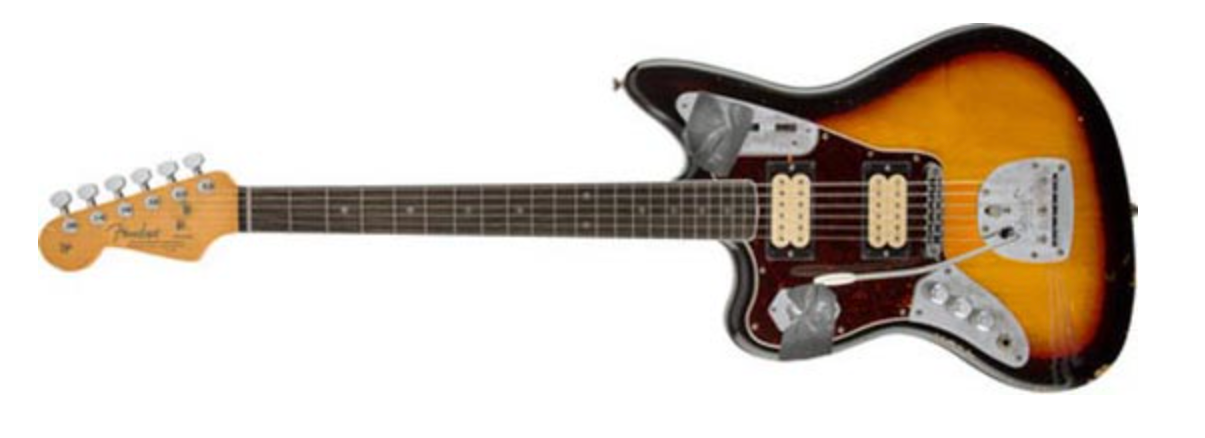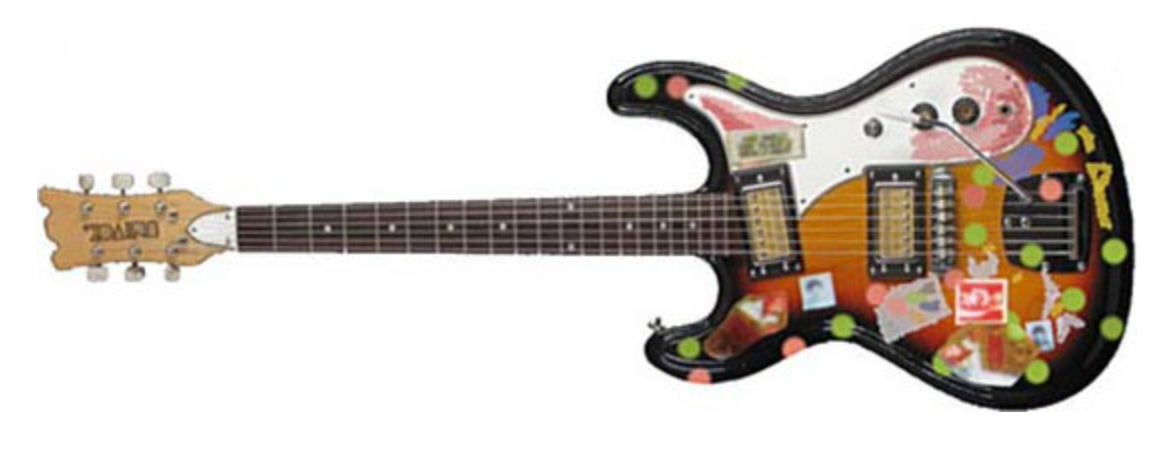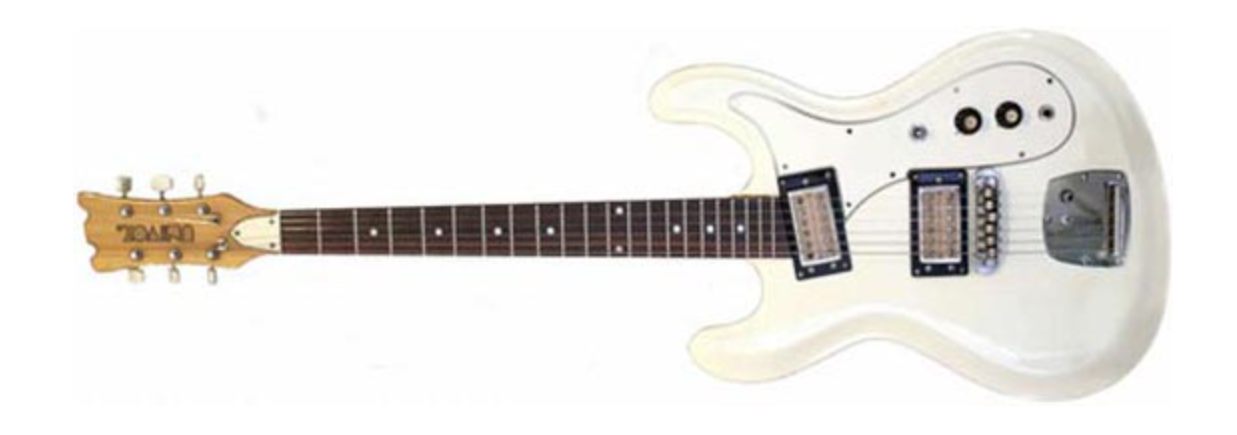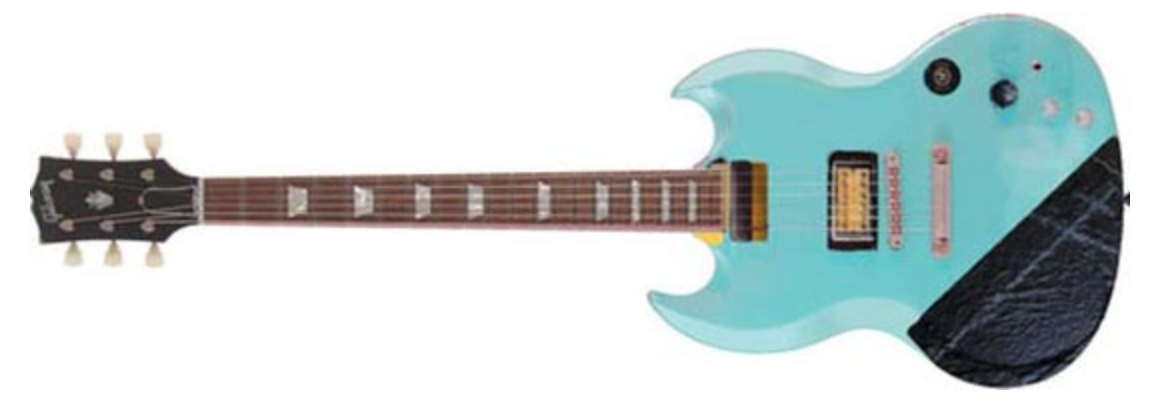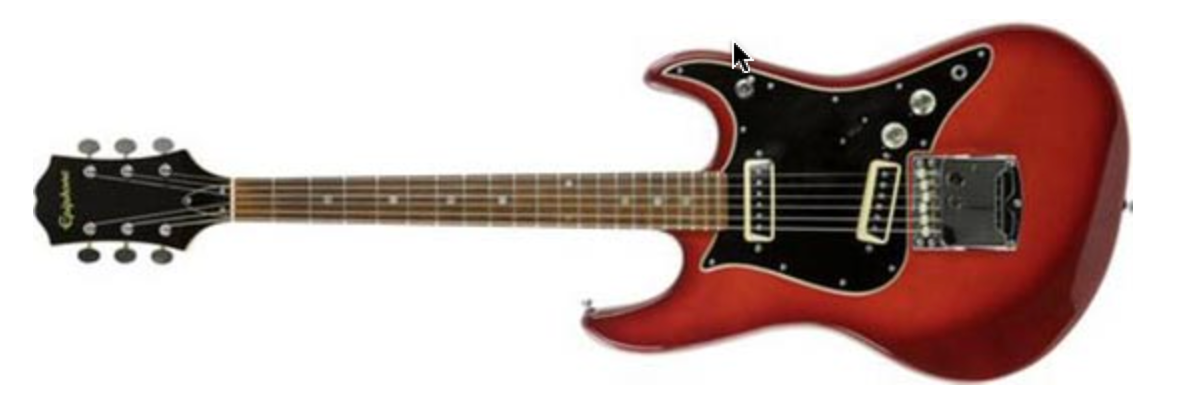Kurt Cobain is well known to be the frontman of Nirvana and he would go on to become the voice of his generation. He helped to shape the course of music history, being the driving force behind the grunge movement. Cobain played riffs were full of distortion and conscientious lyrics that catapulted the band to fame. If you want to play music like the band, make sure to check out our guide for easy Nirvana songs on guitar.
Cobain was most known for playing both his Mustang and Jaguar guitars from Fender along with a Martin D-18 acoustic guitar. We’ve put together a full guide to find out what guitar did Kurt Cobain play along with other gear from his rig.
Kurt Cobain’s Guitars
Kurt Cobain Fender Jag-Stang
Years used – 1993 to 1994
In 1993 Nirvana became known as the ‘biggest rock band in the world’. In light of their fame, Kurt managed to land a deal with the guitar brand Fender who made a guitar just for him. He came up with the concept and this would be a hybrid model of a Jaguar and a Fender Mustang. When his journals were later published the first drawings of this guitar were shown to the world. The images were shared with the engineers at the Fender Custom Shop and Cobain also glued together a picture of half of each of these Fender guitars.
Cobain is quoted as saying, “What I did is I took a picture of a Mustang, a Polaroid picture of a Mustang, and a picture of a Jaguar and then cut them in half and glued them together and told them to build that. So that’s what it is. It’s the Jag-Stang.”
The special hybrid model used the Mustang electronics along with single-coil pickups. The pickguard and tailpiece were also taken from the Mustang but it was the horns and other aesthetics come from the Jaguar. When it came to the headstock, they had some trouble here. Larry Brooks said that they ended up going for the standard Fender shape and it stuck after the initial prototype and play session. This model of guitar is made from alder and it features a 24″ maple neck along with a rosewood fretboard. When you look at the neck you will see there is a Fender Texas Special along with a white DiMarzio H-8 humbucker to make up the bridge.
Little did we know that the Jag-Stand would be one of the last instruments that Kurt Cobain would use. He would use it in rotation with his other Mustang guitars and his 65 Jaguar. The signature prototype that Fender created for him was notably used two months before his untimely passing in 1994.
Fender Mustang Sky-Stang
Years used – 1993 to 1994
Before hitting the road to perform the Utero tour, Cobain would get three Mustang guitars that had all been setup in a similar style. The only real variation between the three was their color. This set would go on to be nicknamed the Sky-Stang Series and he had one in sky blue, blue and red. All three of them were played in his final shows.
The Sky-Stangs came along in 93 and were part of a collaboration Cobain did with Fender. Because he helped design them, they built and routed each guitar with full-sized humbuckers on the bridge. This was Kurt’s own customization that he would do to all of his homemade guitars. The Msutangs came with single coils on the neck, Seymour Duncan JBs and a Gotoh Tune-o-Matic in the stock bridge.
Being used extensively on the 93 and 94 tours with Nirvana, the three guitars also played a part in the MTV Live and Loud performance which was recorded in Seattle. The red version was used in the iconic performance that the band did at the Nulle Parts Ailleurs in Paris, France, in 1994.
The use of these guitars stretched into the last performance that Nirvana would ever do which took place at the Munich Terminal 1 in Germany on March 1st 1994. This was five weeks before Cobain was found dead at his home. The show was pretty hectic as Cobain was suffering from bronchitis because of the amount of touring they were doing. They also experienced a power cut during Come As You Are. During the show, Kurt used one of the blue Sky-Stangs. Recently the same Stang would be auctioned off for $500,000 during the Icons and Idols: Rock ‘n’ Roll Julie’s Sale.
Martin D-18E
Years used – 1993
The Martin D-18E was purchased a few months before the band shot their MTV Unplugged session. The guitar itself is referred to as the only acoustic that Cobain owned, even though this isn’t true. Kurt had a fascination for rare instruments and this one only ran for a year of production. It was one of the first-ever guitars to have electric pickups to hit the market in the 50s.
Even though fans knew Cobain had this guitar he only used it for one performance and there’s actually very little known about it. It originally came with DeArmond pickups but Cobain swapped this out for Bartolini 3AVs so they would sound better with his bronze strings.
The reason why people find this to be one of Kurt’s most infamous instruments is because of the performance it was used for. He would use it to play haunting renditions of Where Did You Sleep Last Night along with a cover of the David Bowie song titled The Man Who Sold the World. This was the only show the instrument would be used for.
White ‘K Sticker’ Fender Stratocaster
Years used – 1990 to 1991
Kurt Cobain and Fender first forged their long-term relationship with this guitar. It was the first left-handed Stratocaster that Cobain would use and it is presumed that he got the instrument before heading to the UK in 1990. Kurt would make his stamp on his gear, placing a sticker with a K on it that was in reference to an indie label who hailed from Olympia in Washington.
The White ‘K Sticker” Fender Stratocaster made its first appearance on the stage in Leeds with the song Blew. It would continue to be one of Cobain’s main instruments throughout 1991 until he got the black Strats.
The guitar itself had three pickups with two single coils and an angled humbucker in the bridge. It doesn’t fit a standard Stratocaster setup so it’s more than likely that Kurt made modifications to it. The rosewood neck paired with the white finish would make this guitar iconic for Cobain, particularly during the Nevermind era. The K sticker was also infamous and Kurt had this emblem tattooed onto his left hand.
Fender Stratocaster White Pick Guard and Black Finish
Years used – 1991
Kurt picked up this guitar in 1991 and it would first take to the stage with the guitarist at the Commodore Ballroom in Vancouver, Canada on March 18th 1991. It looked like your standard left-handed guitar with a black finish and a white pickguard. it had two Duncan single-coils in both the mid and neck sections as well as a full-sized humbucker placed on the bridge.
It was this Stratocaster that Cobain used to record Nevermind when the band went back to the studio for a final time in May 1991. Most of the final songs that ended up on the album were recorded at this stage but there’s a famous incident linked to this instrument. The guitar was said to be giving Kurt some trouble and when he recorded Lithium, he messed up some parts that would end up being riffs for the hidden track on the end of the album titled Endless, Nameless which plays ten minutes after Something in the Way.
As the story goes according to Butch Vig, Cobain and the rest of the band were really frustrated after their fourth take of Lithium. They decided to blast out this hidden track which even the studio staff didn’t know about. Once the track was recorded, a truly pissed off Cobain smashed his guitar and his gear which is a sound that appeared at the last minute of the song. You can now view the remains of the guitar at the Museum of Pop Culture in Seattle along with the story that goes along with its demise.
Fender Stratocaster ‘Vandalism’
Years used – 1991
One of the most iconic Stratocaster’s that Cobain has in his arsenal is this one. It was used during the Nevermind sessions and was acquired around the same time as the Strat we mentioned above. The black body was finished off with a Seymour Duncan JB bridge and two single-coils. At the time these models were the highest quality for the line, available at a more affordable price point.
The guitar was originally a plan black Stratocaster but in the August Cobain decided to emblazon it with a bumper sticker that referenced an album from the Feederz’ titled Teachers in Space. The sticker reads ‘Vandalism: As beautiful as a rock in a cop’s face, Courtest of Feederz: Office of Anti-Public Relations’. After the band had toured Europe with Nevermind, Cobain swapped out the original neck of the guitar for a Fernandes one, using a piece of duct tape on the strap buttons.
Vandalism was used at the height of Nirvana’s career as they were performing on television around the world. This guitar debuted in June 1991 and would make some iconic performances during the Nevermind tour. He notably used the guitar at Reading Festival along with Live at the Paramount.
Used throughout the entire Europen Nevermind tour, it would then reappear on the scene after a few months break in Amsterdam on November 25th. This was then followed by Nirvana’s performance on Top of the Pops, a British TV show, where they played Smells Like Teen Spirit and protested against their mandatory lipsyncing rule the show set out.
This instrument was a main option for Cobain and he would sometimes rotate it with his Fender Jaguar. He ended up smashing it in France on December 7th. The remains of the guitar were put back together by Earnie Bailey who also replaced the original neck back onto the body. It is now displayed at the EMP Museum.
1969 Fender Competition Mustang
Years used – 1991 to 1994
Ever wanted to know what the guitar from Smells Like Teen Spirit is? This is the one. After the music video it instantly became one of Cobain’s signature models. The 1991 video for the song that would become Nirvana’s anthem was recorded on August 17th and this was the starting point for this guitar too. It is unknown whether he received it as part of his deal with Fender or if he purchased it separately. The model rarely came out during live shows but it was used for the first time on a stage at a show in Seattle once the band had come back from Europe.
Kurt ended up modifying this one in a specific way which is something he didn’t do with his other Mustang guitars. He put a Seymour Duncan SH-4 JB humbucker in the bridge position. He also screwed a JB humbucker pickup to the body. The model featured one of the original matching color headstocks to be released at the time, and Kurt Cobain is credited for popularizing this style.
We all know Kurt trashed a fair few of his guitars which is one of the main reasons he wouldn’t use this during live shows. He treasured this piece and cared too much to put it in any sort of danger. It is one of the only guitars he had that managed to survive the Nevermind era and then move on into the release of In Utero.
After many years of smashing up his guitars, in his final years Kurt would nurture his instruments. His beloved Jaguar and this Mustang were among his favorites and he didn’t want to ruin them. In a final interview with Guitar World, Cobain said that he ‘babied’ his Fender guitars.
1965 Fender Jaguar
Years used – 1991 to 1994
This is easily Cobain’s most played guitar and he really put it through the ringer, going through the long tour for Nevermind all the way through to In Utero. In the recording sessions and promotional tours for the latter though the use of this guitar lessened somewhat. The original guitar was bought in 1991 and he first took it on stage in August 1991. It was a stange parallel to the Vandalism Stratocaster which he rotated alongside it until the Jaguar became the main guitar for the tours. When this did become his number one choice for live shows, Cobain would switch out to another random Stratocaster towards the end of his set. This was so he could thrash them as much as he wanted while keeping his few treasured guitars safe.
When Kurt Cobain got this guitar it had already had some modifications. It had an Anvil sturdy case, two DiMarzio pickups and a Super Distotion set in the bridge position. A PAF was in the neck and the bridge had been replaced with a Gibson Tune-O-Matic. The traditional volume knobs were swapped out for standard Fender ones.
The guitar has been used for some of Cobain’s most well-known performances like at Reading Festival, for Saturday Night Live and at the Hollywood Rock Festival in 1993. Even though Kurt said that this was one of his most cherished pieces, he did try to trash it a few times. A show in Rio that wasn’t his best performance saw him slam a cantalopue melon against the body. In the video for Lithium you can see him trying to pull the strings off. Another video would show him hammering it into the ground at a show in Rotterdam, and there’s a rumour that a bouncer was also hit in the face with this guitar.
No matter what Cobain did to it, this guitar survived his rages. Once Cobain died it is believed that Courtney Love gave the guitar to the guitarist from Hole, Eric Erlandson, who used it in the video for Doll Parts. The last viewing of it in public was in 1995 at Lollapalooza when Erlandson bought it onto the stage. Jaguar was an underdog model for Fender but Cobain championed it tirelessly and he influenced many people to pick this piece over the Jazzmaster.
1970s Univox Hi-Flier Phase 3
Years used – 1985 to 1988
From 1985 up until 1987, Kurt would often use this lesser known Univox Hi-Flier Phase 3 guitar. Whether or not this was his first ever guitar is unknown but the rugged sound and low fidelity of the instrument forced him to become a much more resourceful musician. It was using this guitar that Kurt developed some of his now signature tricks like the forceful bend and double bend.
Originally this model was considered to be a cheap guitar that could be found for around $70. Nowadays you will find yourself spending in excess of $1000 to get your hands on one of these models thanks to Kurt. The lighter colored pickguard was wired with single coil humbuckers from 1968. The lower action meant that the sound was dirtier and heavier.
A lot of Hi-fliers would meet their end on stage with Kurt as he smashed their equipment at the end of the shows. Even after Cobain paired up with the Fender brand, he still had an affinity for these models and was used in a music video in the In Utero days, which of course he smashed.
Kurt Cobain Greco Mustang
Years used – 1988 to 1989
This copy of a Fender Mustang was sold to Cobain at a pawn shop and it was apparently heavily modified by the musician. He purchased it after smashing his Univox Hi-Flier at a show in October 1988. Many people point out that this is the first left-handed guitar Cobain owned without having to restring it like other models in his arsenal. This model of Mustang was built for the road and not for the studio. He allegedly oruchased it at Guitar Maniacs which was based in Tacoma, Washington.
Cobain would often use different models of Mustangs during his live shows. The Greco Stang had no visible branding on the headstock and only had a single-coil pickup at the bridge which was identical to his Hi-Flier guitars. This lead people to believe that it actually came from his smashed up Univox. The Mustang went through a few transformations during its time with a clean body and then the addition of a Soundgarden sticker.
Some historical value comes along with this instrument because it was the first Mustang Cobain ever used. It has been said to have been repainted at least three times before Cobain smashed it up violently on stage. There are some remains of an early Mustang are now on display at the Museum of Pop Culture, although it’s not known whether it is this exact guitar or not.
1973 Fender Mustang
Years used – 1989
Another guitar that Cobain would use on the road is the 1973 Fender Mustang. He took this on the tour for Bleach and is possibly the first high-performance instruments he played. We only ever saw it used once at The Sonic Temple in Wilkinsburg, PA in the July of 1989.
After only being used for two shows during the Bleach tour, Cobain slammed the guitar into the stage, leaving him having to trade the remains of it to Sluggo Cawley for a blue Gibson SG. As the timeline goes, Kurt smashed this model on July 12th 1989 and then destroyed another Hi-Flier the next day.
1970s White Univox Hi-Flier Phase 3
Years used – 1989
The white Hi-Flier is another Univox that was a part of Cobain’s history and it was gifted to him when he was on the road in July 1989 by a girlfriend called Tracy Marander. He had a maple necked Univox before this, but when he received this one he figured he could destroy the old one on stage. It stuck with him at the later end of the tour in 1989.
It’s definitely one of the more consistent pieces of gear that Cobain would use and it managed to last through a big part of the Bleach tour. Once he managed to acquire some cheaper brands on the road, this Hi-Flier would give one last show in November in West Germany. After a less than stellar set Kurt smashed the guitar while playing Breed. He wouldn’t be seen playing a Univox as his main instrument again.
Hagstrom II F-200
Years used – 1989
The red Hagstrom II F-200 had a short time with Cobain and was used on the last laps of the European tour. It would act as the backup for his white Hi-Flier until it came to its end. The German made guitar had two single coil pickups with a stop tailpiece. It was considered to be a rare version of the guitar because it had a pickup switch compared to dials.
The Hagstrom lived on until the band went to Italy to perform their last show. It was used as a picture for the unofficial album called Nirvana, It’s All Going Wrong. Cobain, of course, smashed the guitar during the final dates of the tour, specifically in Rome, Italy on November 27th when playing at the Piper Club.
1980s Washburn Force 31
Years used – 1989
The Washburn Force 31 was only used for five shows and was purchased to replace the Hagstrom. It was briefly used on the final leg of the European tour. The model is one of the handful that still remain out there that have been collected and auctions off as historical pieces. The last time it made an appearance on the market was in 2003 when it sold for $1.975 million.
Kurt put a standalone set of Humbuckers on the bridge position and the finish was black to match the fretboard and headstocks. It had a high output and was defined as a treble guitar which would have created a more distinctive sound in the five shows it was used for.
Much like many of Kurt’s guitars, the model was made memorable when he trashed it in London at the Sub Pop Lame Festive held at the Astoria Theatre. The band supported Mudhoney before heading home. It was a memorable show for the band as it was the first time they had drawn in major crowds at a big venue and it marked the real start of the grunge movement. Playing in front of 2000 people, it would be the first time many people witnessed a major grunge event, which of course ended with Cobain smashing the guitar to pieces.
1970s Blue Gibson SG
Years used – 1989 to 1990
The Blue Gibson SG originally belonged to Slugo Crawley who traded this model in for Cobain’s smashed up Mustang. He wanted it so that he could hang another broken guitar on his wall. It didn’t make an appearance on stage right away, probably because it was unplayable when he first got it. Kurt most probably spent some time refurbishing it and debuted the model in February.
After half a year of playing it the SG was further modified to feature an old Univox humbucker on the bridge and it’s more than likely that he repainted as well. Black tape was wrapped around the bottom of the guitar. It was reportedly used for just two shows in Mexico and the band smashed all of the equipment on the 17th after a performance of Breed. The stage battery at this point was legendary because Kurt tried to turn his SG into a pogo stick but failed so he slammed the neck of the guitar instead, pickedup the fretboard and beat up the body with it.
Vintage Epiphone ET 270
Years used – 1990
Cobain certainly had a love for unusual guitars and this probably stemmed from not being able to afford the more higher end models when he first started with the band. This lead him to love certain models, and love destroying them as part of his performance as well. The Epiphone ET 270 had a good run with the band when Cobain first got it in 1990. It was seen at the opening show for Nirvana that year and featured in the alternate video for In Bloom.
For most of 1990 Kurt would use this as his standard guitar before moving on to more high-profile models. It met its end when Nirvana played in New York at the Pyramid Club on April 26th 1990. There isn’t a video of the guitar being trashed, but there is some photo’s of Cobain doing his thing and smashing it into pieces.
Kurt Cobain Homemade Mustang
Years used – 1990
It’s well known that Cobain got through a lot of gear during his career and this one had both its first and last show in Long Beach, California at the Bogart Club. Krist and Kurt had an on stage duel in the February of 1990 which would result in Cobain popping the neck off this Mustang and splitting the body open. He then stepped on the remains which really finished it off. It’s more than likely that Kurt set this guitar up himself and it was similar to the sonic blue model he used on the next tour.
Homemade Mustang 2
Years used – 1990
One of Cobain’s most famous homemade models was this Mustang which followed on from the Pink version which he killed on stage that February. The guitar is known to be featured int he alternative version of In Bloom that was recorded under the Sub Pop label. This Mustnag has a vague origin story along with its use in the studio and for live performances. We don’t even know if its the same pink guitar just painted blue.
The guitar made its debut at the Amnesty International benefit gig on April 27th and it would become his standard instrument for the next three scheduled gig dates. We don’t know if it ended up being destroyed by Kurt on stage or not, although we can probably safely assume so.
Kurt Cobain’s Amps
1960s Fender Twin Reverb
Years used – 1989 to 1990
Kurt’s main output for the recording of Bleach was this two channel amp with a clean tone. The purer quality of the sound allows Cobain to mix in some dirtier tones using his Boss DS-1 pedal during the recording sessions for Nirvana’s first album. However, Kurt didn’t actually own this amp, he borrowed it from Jack Edino who was a producer on Bleach. During this time he started to like the amp and once the promo tour throughout Europe was done, he decided to purchase a Silverface one of his own.
Mesa/Boogie Studio Preamp
Years used – 1990 to 1994
Kurt discovered this amp prior to the show that they played at Cat’s Cradle on May 1st 1990. Ever since then this became his standard amp and he loved that he could play with it. It’s one of the few pieces that stuck as part of his rig despite all of the smashing tendencies Kurt had. It well all the way through to the In Utero days.
Kurt Cobain’s Pedals
Boss DS-1
Years used – 1988 to 1994
This pedal became very popular after Cobain used it and it was the only pedal he used to record Bleach. It gave him the power and that edge he needed to make Nirvana stand out from the crowd. This pedal is still as important now as it was back in their day and it was featured on their debut album all the way into In Utero where Cobain used the DS-1 and DS-2 models.
Electro-Harmonix Small Clone
Years used – 1991 to 1994
Kurt resorted to the Small Clone as an affordable and effective alternative to other pedals he used at the time. The Polychorus and Echoflanger both kept breaking down but Cobain relied on pedals to create his modulation effects. It gives out a full chors effect and provided the modulation on Come as You Are and Heart Shaped Box.
Conclusion
Cobain changed the world of music as we know it and his status amongst guitar players is debated because of his sloppy style. No matter what, while he might not have been the genius that Hendrix or Van Halen are, he was able to develop his own style. He is most certainly up there with some of the most iconic figures in rock history and you could see he had a real passion for his craft. It’s certain that he is missed even no wand it would have been great to see what sort of music he would have come up with if he hadn’t of passed at such a young age.
FAQs
What guitar did Kurt Cobain want to buy?
It’s not clear what kind of guitar Kurt Cobain wanted to buy but with the success of the band, we’re pretty sure he could have bought any instrument he wanted.
What guitar did Kurt Cobain use to play Nevermind?
Kurt used a Harmony Stella twelve string guitar that he purchased for a measly $30 at a pawnshop. He would use this guitar to record most of the acoustic guitar tracks played by Nirvana.
What did Kurt Cobain call his guitar?
The Jag-Stang name was Cobain’s idea and this was a combination of both of his favorite types of guitars.




